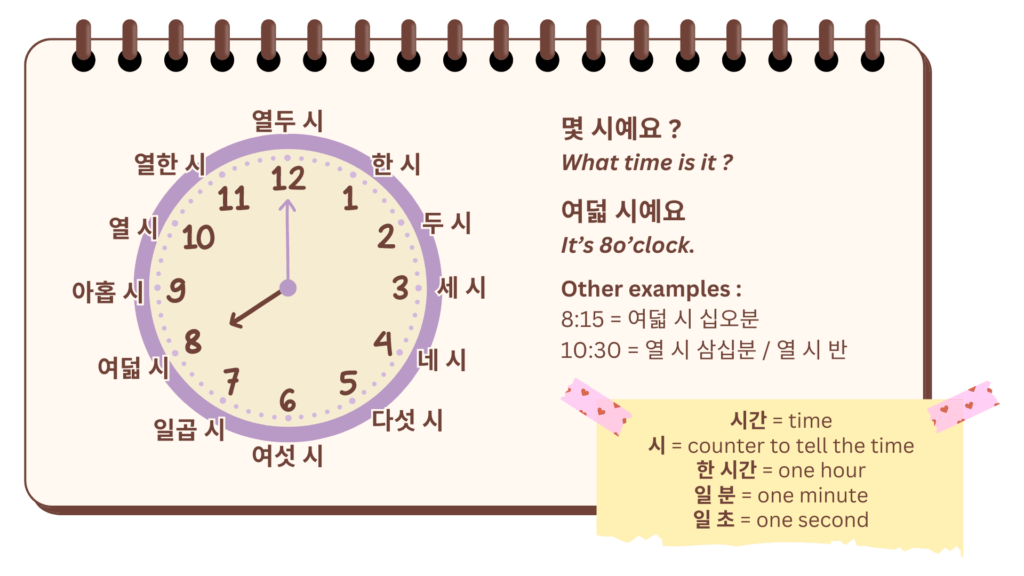Table of Contents
Korean Reading Practice
Welcome to Korea!

***
지금 일곱시예요.
루키 씨가 여덟 시 삼십분에 한국 공항에 도착할 거예요.
우리 집에서 인천 공항까지 한 시간 걸려요.
지하철로 갈 거예요. 일찍 도착하고 싶어요.
그래서 지금 출발해요.

곧 올거예요.
Vocabulary
| 한국어 | 영어 |
|---|---|
| 오늘 | today |
| 공항 | airport |
| 친구 | friend |
| 한국 사람 | Korean person |
| 미국 사람 | American person |
| 1년 동안 | for 1 year |
| 그래서 | so, therefore |
| 아주 | very |
| 기쁘다 | to be happy |
| 이름 | name |
| 일곱 | seven |
| 여덟 시 삼십분 | 8:30 |
| 지하철 | subway |
| 일찍 | early |
| 도착하다 | to arrive |
| 출발하다 | to depart |
| 기다리다 | to wait |
| 커피 한잔 | a cup of coffee |
| 마시다 | to drink |
| 맛있다 | to be delicious |
| 곧 | soon |
| 오랜만 | after a long time |
| 환영하다 | to welcome |
| 기분 | feeling, mood |
| 어떻다 | to be how |
| 피곤하다 | to be tired |
| 많이 | a lot, much |
| 비행기 | airplane |
| 잠을 자다 | to sleep |
| 빨리 | quickly |
| 이야기하다 | to talk, to have a conversation |
Grammar points
The particle -로/-으로
The particle (으)로 (or 으로) is used to indicate the direction, method, cause, role, and selection, among others. It can mean: by, with, using ~, as, for to… It is a versatile particle.
In the story, it is used to indicate the method :
“지하철로 갈 거예요.” (I will go by subway.)
Other examples :
이걸로 주세요. (Please give me this one.)
한국어로 말해요. (Speak in Korean.)
선생님으로 일해요. (I work as a teacher)
학교로 가요. (I go to school – I am heading towards school)
-지요? / -죠? ~ Sentence Ending
This grammar pattern can be used in various cases. In the story, it is used to confirm information or seek agreement from the listener.
Binu assumes that Luki is tired.
“많이 피곤하지요?” (You’re very tired, right?)
In our last story (Binu and Zapi at the swimming pool), Binu says :
“예쁘죠?” (It’s pretty, right?)
Seeking your agreement, that Binu’s swimming suit is pretty!
Korean Time System
Korean Time System
In Korean, telling time combines native Korean numbers for hours and Sino-Korean numbers for minutes.
You will need to know both systems to tell the time, or in many situations requiring numbers in Korean. But let’s focus on time today.
| Native Korean Numbers (for hours) | Sino-Korean Numbers (for minutes) |
| 1 : 하나 → 한 시 (1 o’clock) 2 : 둘 → 두 시 (2 o’clock) 3 : 셋 → 세 시 (3 o’clock) 4 : 넷 → 네 시 (4 o’clock) 5 : 다섯 → 다섯 시 (5 o’clock) | 1 : 일 → 일 분 (1 minute) 2 : 이 → 이 분 (2 minutes) 3 : 삼 → 삼 분 (3 minutes) 4 : 사 → 사 분 (4 minutes) 5 : 오 → 오 분 (5 minutes) |

Other Texts For True Beginners
- Korean Reading for Beginners : Swimming Pool
- Korean Reading for Beginners : Please help !
- Korean Short Story : 공부 ? Study ?
- Korean Short Story : Phone conversation
- Korean Reading Practice : Morning Story
Study Method for Texts
If you’re not familiar with text study, here’s a method I would suggest you try.
Since we’ve recently started making YouTube videos for each reading practice we post, I would suggest you watch the video to study the text.
The video is divided as follows :
- Korean voice only, with pictures to help the understanding
- Korean subtitles + translation
- Additional notes
By following the video first, you’ll get a good grasp of the text. Then, you can come back here and study it from here.




